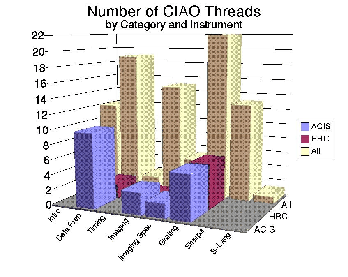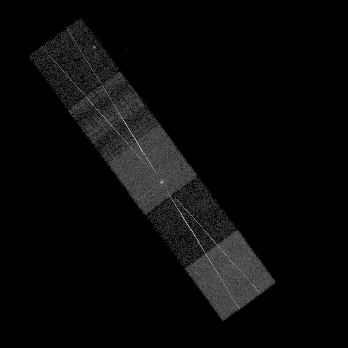 |
| 4th Chandra/CIAO Workshop |
| 20-22 May 2002 |
| Center for Astrophysics |
One of the most popular links within the CIAO WWW pages is the one leading to the ``Science Threads". Our experience early in the Chandra mission showed us that ``thick manuals" are not always the best way to provide documentation to users when step-by-step instructions represent their initial needs. In our web-based era we have the possibility of producing documents which are easy to update and easy to expand and that is how our data analysis threads came to be.
Threads are processing recipes designed to teach users by leading, step-by-step, through procedures which range from basic to significantly complex, but each thread describes the process in the same easy-to-follow manner. Examples of the results from a thread are shown in Fig. 13 (``Before") and Fig. 14 (``After"). Since the first pioneering data analysis threads appeared on the CIAO web pages with the CIAO 1.1 releases (in December 1999) a lot of effort has been devoted to improving the thread structure, the thread content and especially the number of available threads in order to make them more reliable, easy to read, user-friendly and scientifically useful.
A general overview on threads appeared in the 2001 Chandra newsletter. The most recent improvements, introduced with the CIAO 2.2 release in October 2001 partially responding to user's comments, include a more uniform and slimmer format (information common to various threads is summarized outside the threads and linked from them ); each analysis tool is clearly identified and linked to its ahelp file; a history block is added at the end of each thread to make it easier to find the date and kind of updates; and finally all threads are now available in PDF format (in letter (L) or A4-size) so that good quality hardcopies may be created. (Also, for the computer nerds among us, threads are now written in XML language and then automatically translated into HTML and PDF via the XSLT and HTMLDOC programs.)
Threads are quickly becoming too numerous to be listed all in one page (there are more that 70 at the time of writing but more are added weekly and advertized on the chandra-users mailing list) so a division into categories is presented from the main thread page. The challenge which awaits us for the future is how to guide users around this ever-growing list. For this we are designing top-level guides through threads which we plan to introduce in forthcoming releases. The distribution of threads is shown in Figure 12.
Another short term goal is to automate as many threads as possible in
the form of ``scripts" to simplify the execution of tasks otherwise
long or complicated: this has already been done in several cases and
the original ``scripts" are now ``promoted" to the status of
(super)tools with their own parameter and help files. The cycle
individual tools
![]() threads
threads
![]() scripts
scripts
![]() new super tool is
complete!
new super tool is
complete!
The documentation effort for CIAO is certainly ongoing as software continues to be enhanced and becomes increasingly complex and powerful. Users' needs and feedback are our main sources for improvement therefore we strongly encourage you to e-mail suggestions for improvements or for new threads to ciaoenhancements@head-cfa.harvard.edu.
If you want to know more about threads or the CIAO data analysis system please come to our next Chandra/CIAO workshop scheduled for May 20-22 2002. (Details are available on the workshop web page). Useful WEB references:
The main CIAO WEB page can be found at:
http://chandra.ledas.ac.uk/ciao
(UK mirror site)
Data analysis threads are at:
http://cxc.harvard.edu/ciao/documents_threads.html
Workshop information is at:
http://cxc.harvard.edu/ciao/workshop.html
Questions about CIAO should be addressed to the CXC Help Desk at
http://cxc.harvard.edu -> HELP_DESK
- Antonella Fruscione on behalf of the CIAO documentation team
 |
 |